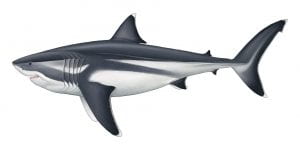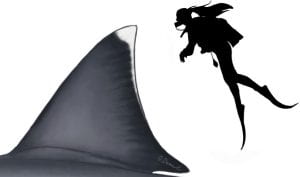 Bristol MSc in Palaeobiology student Jack Cooper has just published his thesis work, and to great acclaim. He studied the legendary giant shark Megalodon (Otodus megalodon) and his detailed morphometric study has revealed the size of the rest of its body, including fins that are as large as an adult human.
Bristol MSc in Palaeobiology student Jack Cooper has just published his thesis work, and to great acclaim. He studied the legendary giant shark Megalodon (Otodus megalodon) and his detailed morphometric study has revealed the size of the rest of its body, including fins that are as large as an adult human.
Today, the most fearsome living shark is the Great White, at over six metres (20 feet) long, which bites with a force of two tonnes. Its fossil relative, the big tooth shark Megalodon, star of Hollywood movies, lived from 23 to around three million years ago, was over twice the length of a Great White and had a bite force of more than ten tonnes.
Jack used a number of mathematical methods to pin down the size and proportions of this monster, by making close comparisons to a diversity of living relatives with ecological and physiological similarities to Megalodon. The project was supervised by shark expert Dr Catalina Pimiento from Swansea University and Professor Mike Benton, a palaeontologist at Bristol. Dr Humberto Ferrón of Bristol also collaborated.
Their findings are published today in the journal Scientific Reports.
Jack Cooper said: “I have always been mad about sharks. As an undergraduate, I have worked and dived with Great whites in South Africa – protected by a steel cage of course. It’s that sense of danger, but also that sharks are such beautiful and well-adapted animals, that makes them so attractive to study. Megalodon was actually the very animal that inspired me to pursue palaeontology in the first place at just six years old, so I was over the moon to get a chance to study it. This was my dream project. But to study the whole animal is difficult considering that all we really have are lots of isolated teeth.”
 Previously the fossil shark was only compared with the Great White. Jack and his colleagues, for the first time, expanded this analysis to include five modern sharks. The results suggest that a 16-metre-long Otodus megalodon likely had a head round 4.65 metres long, a dorsal fin approximately 1.62 metres tall and a tail around 3.85 metres high. This means an adult human could stand on the back of this shark and would be about the same height as the dorsal fin.
Previously the fossil shark was only compared with the Great White. Jack and his colleagues, for the first time, expanded this analysis to include five modern sharks. The results suggest that a 16-metre-long Otodus megalodon likely had a head round 4.65 metres long, a dorsal fin approximately 1.62 metres tall and a tail around 3.85 metres high. This means an adult human could stand on the back of this shark and would be about the same height as the dorsal fin.
The paper: ‘Body dimensions of the extinct giant shark Otodus megalodon: a 2D reconstruction’ by J. A. Cooper, C. Pimiento, H. G. Ferrón, and M. J. Benton in Scientific Reports. Read the paper here.
You can also watch and listen to Jack talking about his discoveries here. Jack has also written a great feature article (Cooper, J.A. 2020. Scaling a giant. Geoscientist 30(10), 10-15), and you can read it here.

